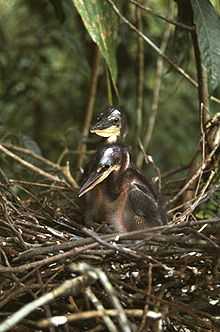Agami heron
| Agami heron | |
|---|---|
.jpg) | |
| Conservation status | |
| Scientific classification | |
| Kingdom: | Animalia |
| Phylum: | Chordata |
| Class: | Aves |
| Order: | Pelecaniformes |
| Family: | Ardeidae |
| Genus: | Agamia L. Reichenbach, 1853 |
| Species: | A. agami |
| Binomial name | |
| Agamia agami (Gmelin, 1789) | |
The agami heron (Agamia agami) is a medium-sized heron. It is a resident breeding bird from Central America south to Peru and Brazil.
It is sometimes known as the chestnut-bellied heron, and is the only member of the genus Agamia (Reichenbach, 1853).

The agami heron's habitat is forest swamps and similar wooded wetlands. They nest in colonies on platforms of sticks in trees over water, which may gather more than 100 nests (Fleck 2003). The normal clutch is two blue eggs. This uncommon and localised species is 66–76 cm in length. It is short-legged for a heron, but has a very long thin bill. The neck and underparts are chestnut, with a white line down the centre of the foreneck, and the wings are green. There are wispy pale blue feathers decorating the head, sides of the foreneck, and lower back. The legs, bill, and bare facial patch are dull yellow.
The sexes are similar, but immature agami herons are largely brown above with a white foreneck, and streaked brown-and-white underparts.
Despite its stunning plumage, this reclusive species' preference for shade and overhanging vegetation means that it is rarely seen at its best.
This is a quiet bird, but pairs and family groups may make various snoring or rattling sounds.
Agami herons stalk their fish prey in shaded shallow water, often standing still or moving very slowly. They rarely wade in open water. They also take frogs, small reptiles, and snails.
References
- ↑ BirdLife International (2012). "Agamia agami". IUCN Red List of Threatened Species. Version 2013.2. International Union for Conservation of Nature. Retrieved 26 November 2013.
- Birds of Venezuela by Hilty, ISBN 0-7136-6418-5
- Fleck, L. C. (2003). Aspectos reprodutivos e conservação de um ninhal de Agamia agami (AVES: ARDEIDAE) na RDS Amanã – AM. Anais do XI Congresso Brasileiro de Ornitologia, p. 3.
External links
![]() Media related to Agami heron (Agamia agami) at Wikimedia Commons
Media related to Agami heron (Agamia agami) at Wikimedia Commons
- Agami heron videos on the Internet Bird Collection
- Images from Brazil
- Stamps (for Suriname) with RangeMap
- Agami heron photo gallery VIREO
- Photo; Article sunbirdtours
- Photo--Very High Res; Article turtleprotection.org
- "The Agami Heron" article & Photo--Medium Res—"Birds-Belize"
